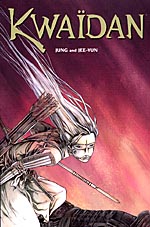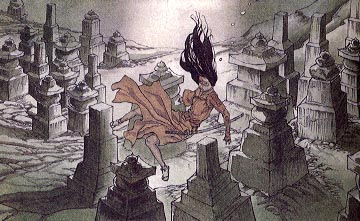 Written by Jung and Jee-Yun
Written by Jung and Jee-Yun
Art by Jung
144 pages, color
Published by Dark Horse
Ghost stories are often centered around the emotion of love. It makes sense, if you follow the idea that ghosts are kept in our world through a strong emotion. It’s what Jung and Jee-Yun use in their graphic novel Kwaïdan, as a pair of spirits in 12th Century Japan are killed prematurely and struggle to be reunited even after death. What we get here, though, is a bit more than it first appears.
Setsuko is a young girl in 14th Century Japan who was born without facial features. Forced to wear a mask and shunned by all, her life is miserable and meaningless until she begins to discover the true nature of her birth and her connection to two spirits that died two hundred years earlier. But can a girl without a face and a blind artist somehow defeat the witch whose immense powers have already held the spirits captive for two hundred years?
Jung and Jee-Yun’s story in Kwaïdan is certainly inventive, forever shifting alliances and introducing new characters. The idea of Orin’s love for Nanko driving her to such extremes to come back to life comes across really well, and provides one of the most dramatic scenes of the book. Once the book shifts over to Setsuko, though, the book loses some of its strength. It seems to almost lurch from one encounter to the next, and Setsuko herself seems a strange combination of dimwitted and flighty, abandoning others and ignoring advice at the drop of a hat. There are a lot of great ideas in Kwaïdan, like the army of demonic children or Orin’s ghost being tied to the water, but they never seem to all come together in a strong manner.
 Where the story in Kwaïdan ultimately fails, the art succeeds wonderfully. This is one of the most attractive books I’ve seen published all year, Jung drawing anything and everything imaginable. Characters don’t so much move as they almost flow across the page, drawn with a real sense of grace about them. Every panel is full of detail, bringing a strong sense of realism to otherwise impossible events. Scenes of submerged tombstones and bamboo forests are drawn so perfectly it’s like you’re actually there, bringing menace or tranquility as needed by the script. Even the coloring is masterful, giving a soft glow to underwater scenes or a bright, harsh red to a blood demon striking without warning. I don’t know what else Jung has drawn before Kwaïdan, but I must say that I am desperate to find out the anwer.
Where the story in Kwaïdan ultimately fails, the art succeeds wonderfully. This is one of the most attractive books I’ve seen published all year, Jung drawing anything and everything imaginable. Characters don’t so much move as they almost flow across the page, drawn with a real sense of grace about them. Every panel is full of detail, bringing a strong sense of realism to otherwise impossible events. Scenes of submerged tombstones and bamboo forests are drawn so perfectly it’s like you’re actually there, bringing menace or tranquility as needed by the script. Even the coloring is masterful, giving a soft glow to underwater scenes or a bright, harsh red to a blood demon striking without warning. I don’t know what else Jung has drawn before Kwaïdan, but I must say that I am desperate to find out the anwer.
Ultimately Kwaïdan‘s story just doesn’t come together, which is a real shame since it’s paired up with such gorgeous art. With stronger writing this would have been an obvious choice for Best of 2004 lists everywhere, but in the end Kwaïdan will really just be remembered for its art. With art as beautiful as Jung’s, though, I can’t fault Dark Horse for printing the book. I may not ever read Kwaïdan again, but I’ll definitely look at its art over and over again.
Purchase Links:
